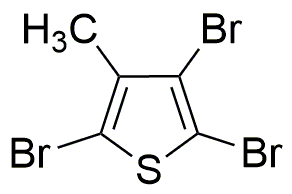2,3,5-Tribromo-4-methylthiophene is widely utilized in research focused on:
- Organic Synthesis: This compound serves as a key intermediate in the synthesis of various organic molecules, particularly in the development of brominated thiophene derivatives, which are valuable in pharmaceuticals and agrochemicals.
- Material Science: Its unique properties make it suitable for creating advanced materials, such as conductive polymers and organic semiconductors, which are essential in electronics and optoelectronic devices.
- Environmental Chemistry: The compound is used in studies investigating the degradation of brominated compounds in the environment, helping researchers understand their impact and develop better waste management strategies.
- Biological Research: It has potential applications in medicinal chemistry, particularly in the design of new drugs targeting specific biological pathways, enhancing the efficacy of treatments.
- Analytical Chemistry: This chemical is employed as a standard in various analytical techniques, aiding in the calibration and validation of methods used to detect and quantify brominated compounds in complex mixtures.
General Information
Properties
Safety and Regulations
Applications
2,3,5-Tribromo-4-methylthiophene is widely utilized in research focused on:
- Organic Synthesis: This compound serves as a key intermediate in the synthesis of various organic molecules, particularly in the development of brominated thiophene derivatives, which are valuable in pharmaceuticals and agrochemicals.
- Material Science: Its unique properties make it suitable for creating advanced materials, such as conductive polymers and organic semiconductors, which are essential in electronics and optoelectronic devices.
- Environmental Chemistry: The compound is used in studies investigating the degradation of brominated compounds in the environment, helping researchers understand their impact and develop better waste management strategies.
- Biological Research: It has potential applications in medicinal chemistry, particularly in the design of new drugs targeting specific biological pathways, enhancing the efficacy of treatments.
- Analytical Chemistry: This chemical is employed as a standard in various analytical techniques, aiding in the calibration and validation of methods used to detect and quantify brominated compounds in complex mixtures.
Documents
Safety Data Sheets (SDS)
The SDS provides comprehensive safety information on handling, storage, and disposal of the product.
Product Specification (PS)
The PS provides a comprehensive breakdown of the product’s properties, including chemical composition, physical state, purity, and storage requirements. It also details acceptable quality ranges and the product's intended applications.
Certificates of Analysis (COA)
Search for Certificates of Analysis (COA) by entering the products Lot Number. Lot and Batch Numbers can be found on a product’s label following the words ‘Lot’ or ‘Batch’.
*Catalog Number
*Lot Number
Certificates Of Origin (COO)
This COO confirms the country where the product was manufactured, and also details the materials and components used in it and whether it is derived from natural, synthetic, or other specific sources. This certificate may be required for customs, trade, and regulatory compliance.
*Catalog Number
*Lot Number
Safety Data Sheets (SDS)
The SDS provides comprehensive safety information on handling, storage, and disposal of the product.
DownloadProduct Specification (PS)
The PS provides a comprehensive breakdown of the product’s properties, including chemical composition, physical state, purity, and storage requirements. It also details acceptable quality ranges and the product's intended applications.
DownloadCertificates of Analysis (COA)
Search for Certificates of Analysis (COA) by entering the products Lot Number. Lot and Batch Numbers can be found on a product’s label following the words ‘Lot’ or ‘Batch’.
*Catalog Number
*Lot Number
Certificates Of Origin (COO)
This COO confirms the country where the product was manufactured, and also details the materials and components used in it and whether it is derived from natural, synthetic, or other specific sources. This certificate may be required for customs, trade, and regulatory compliance.


